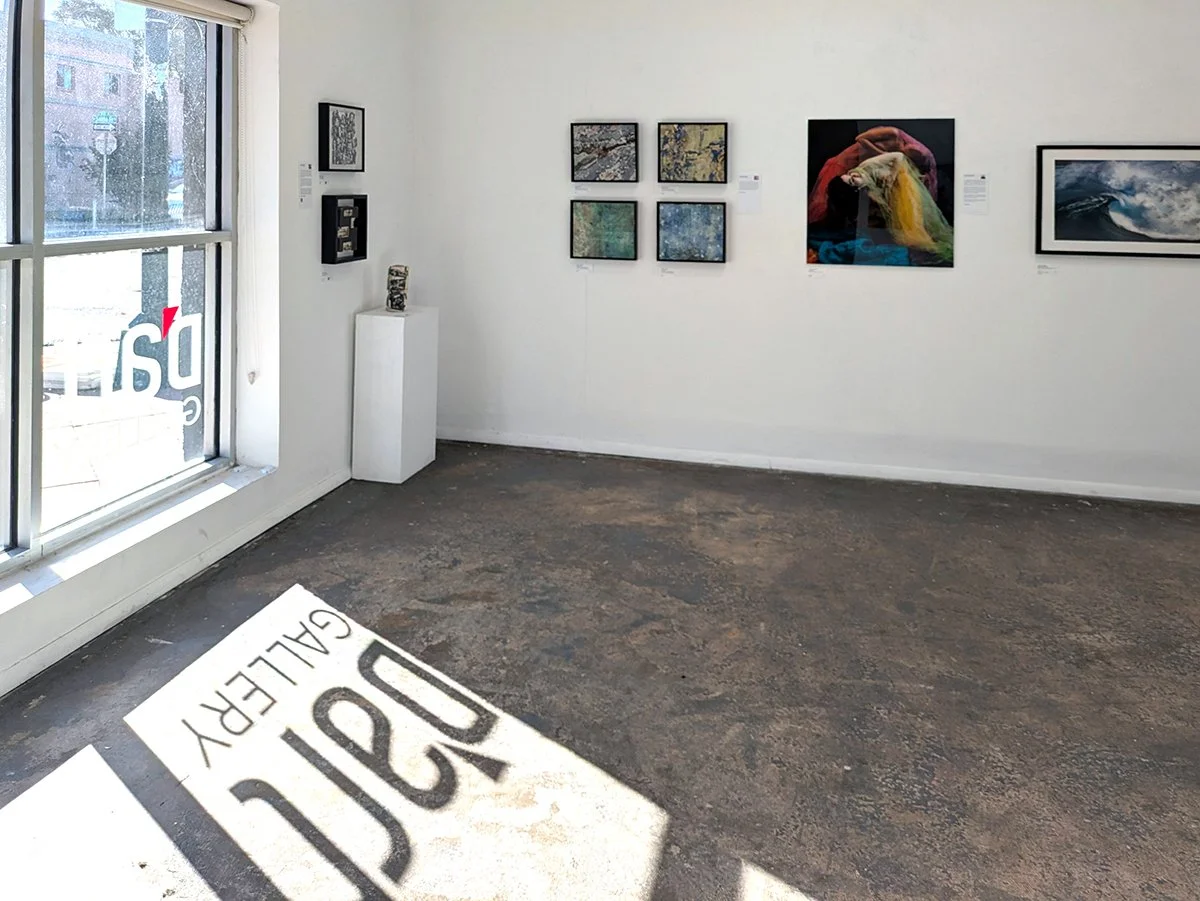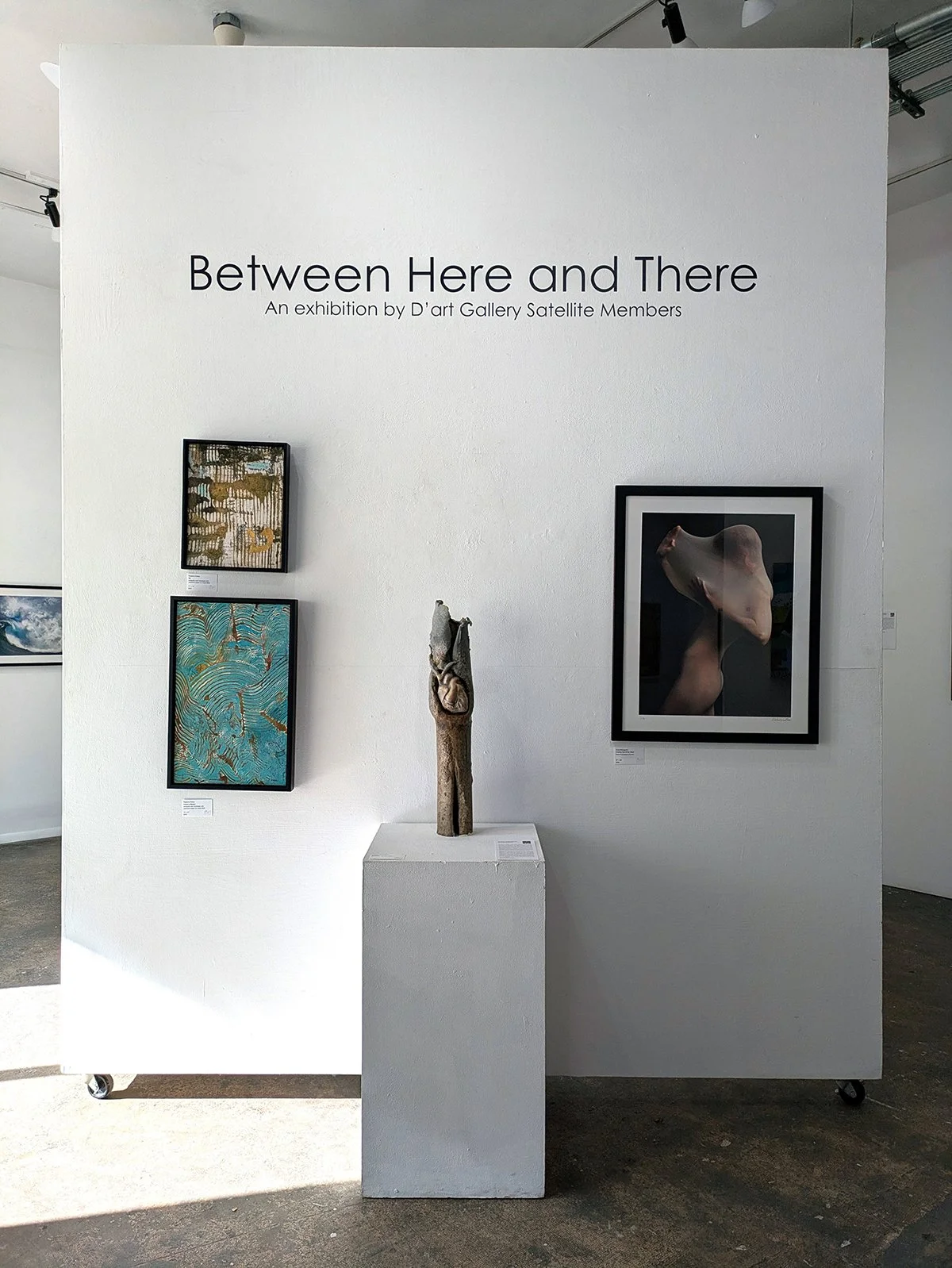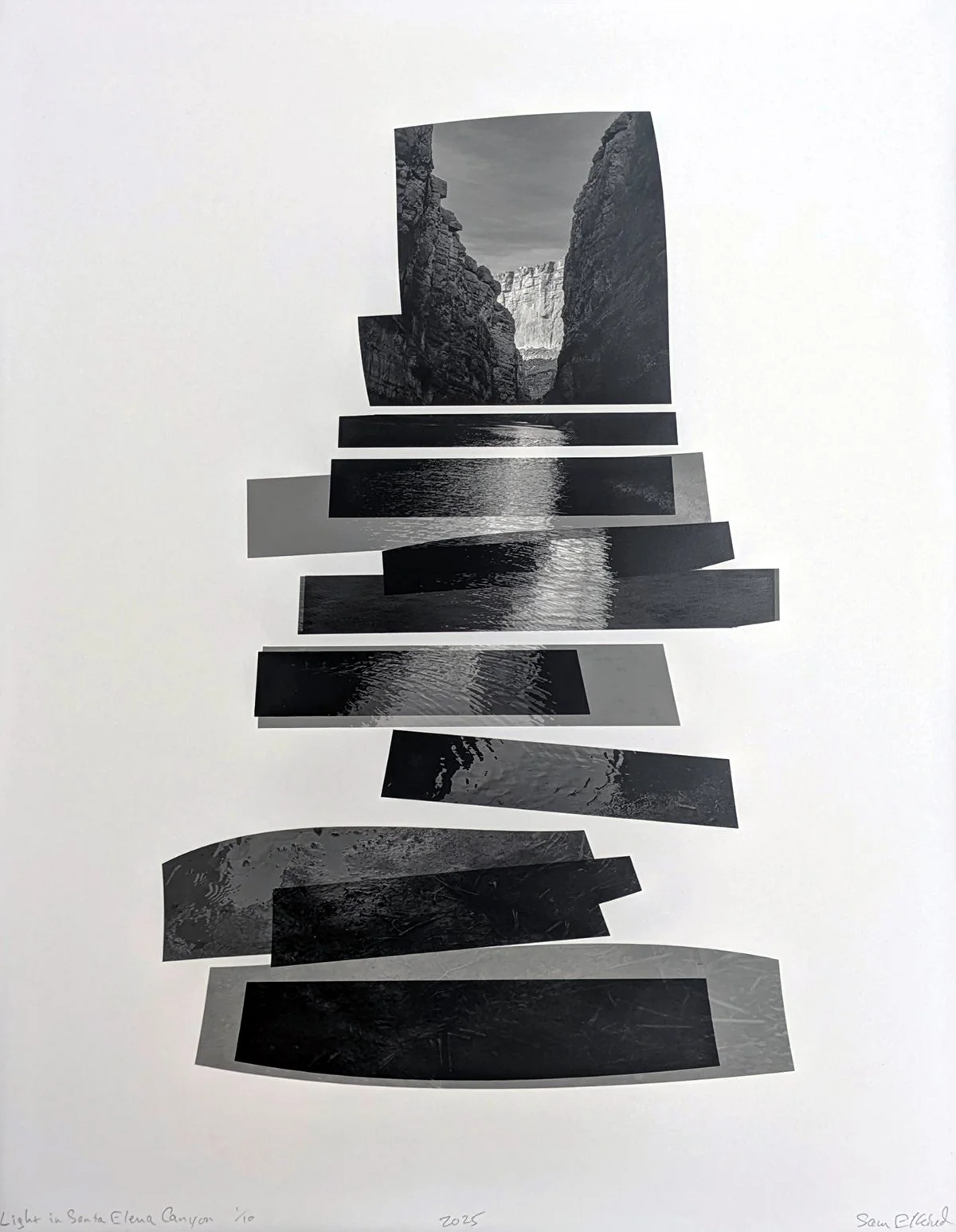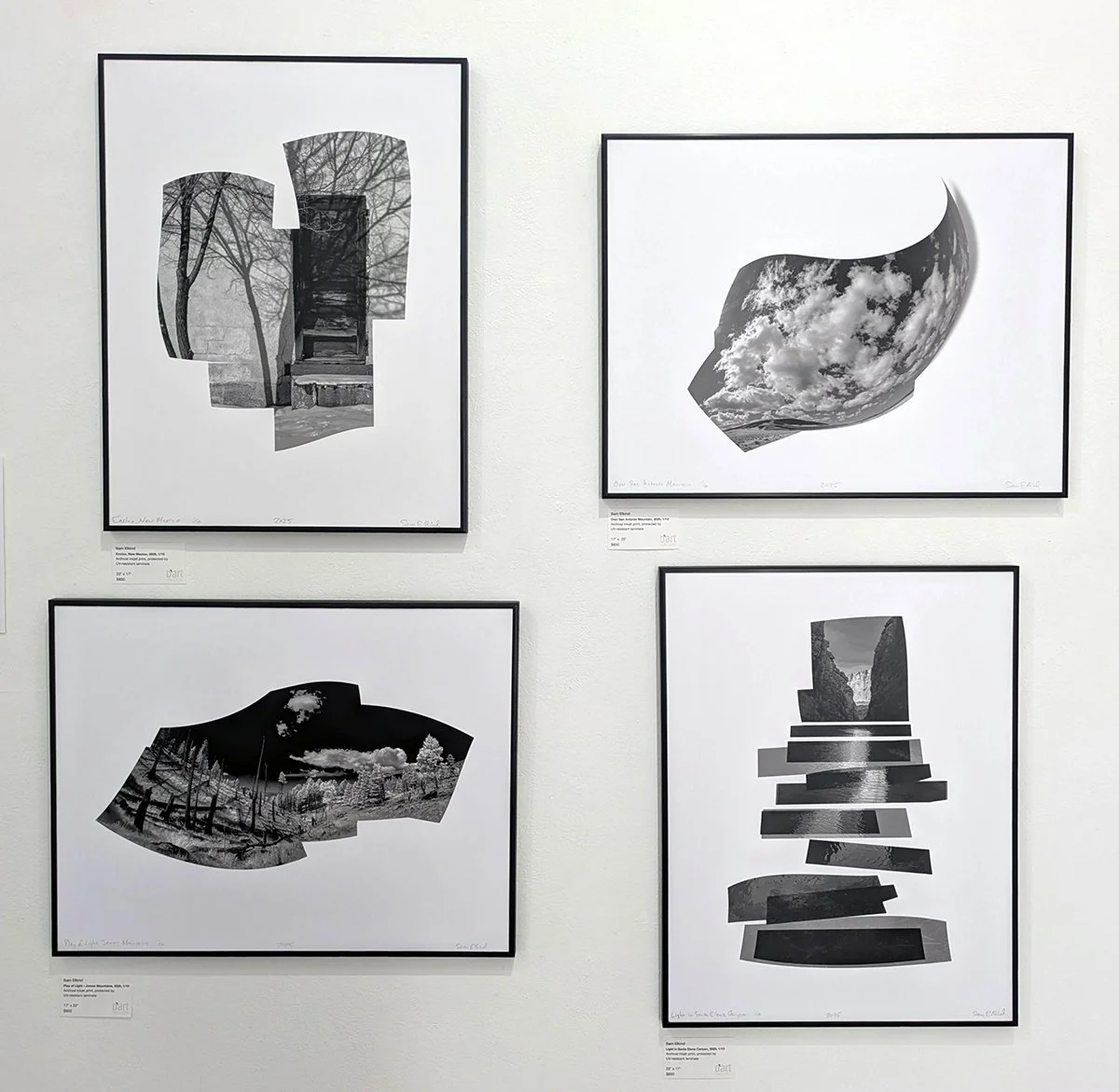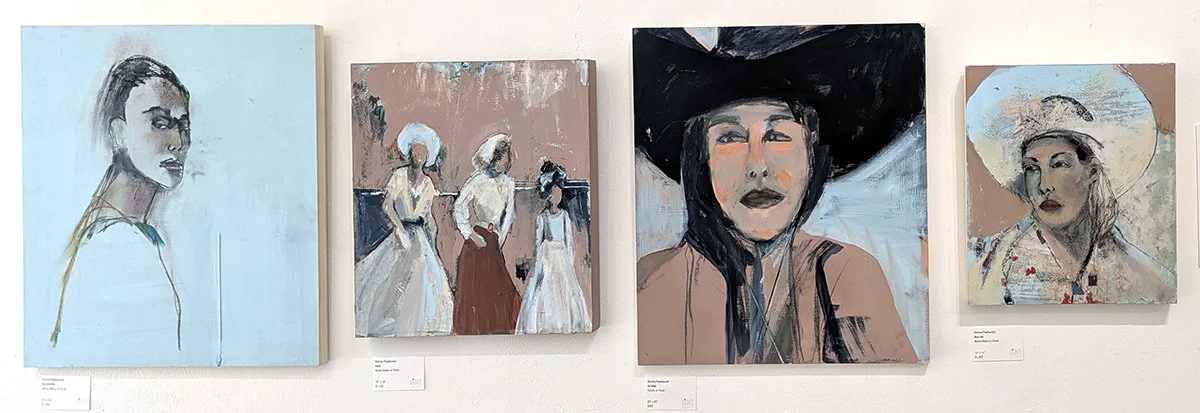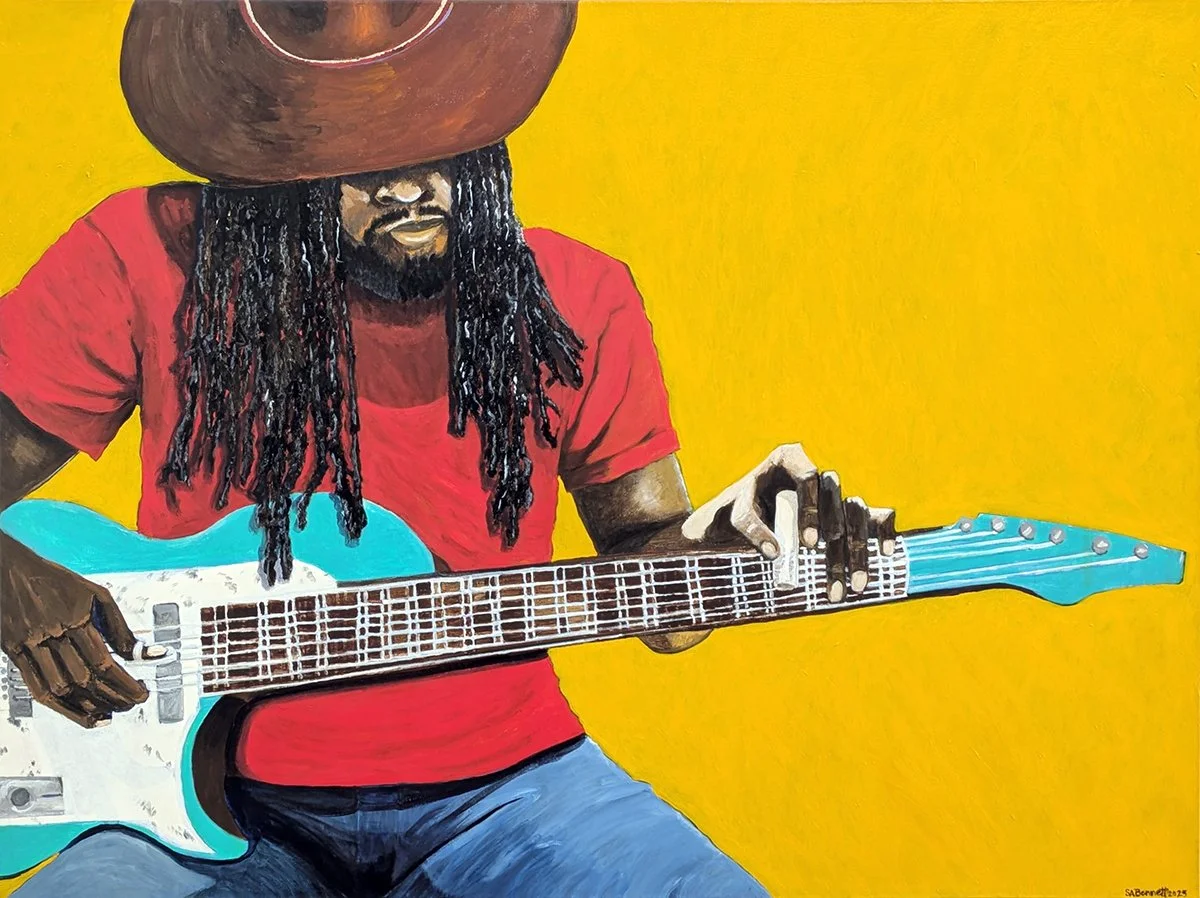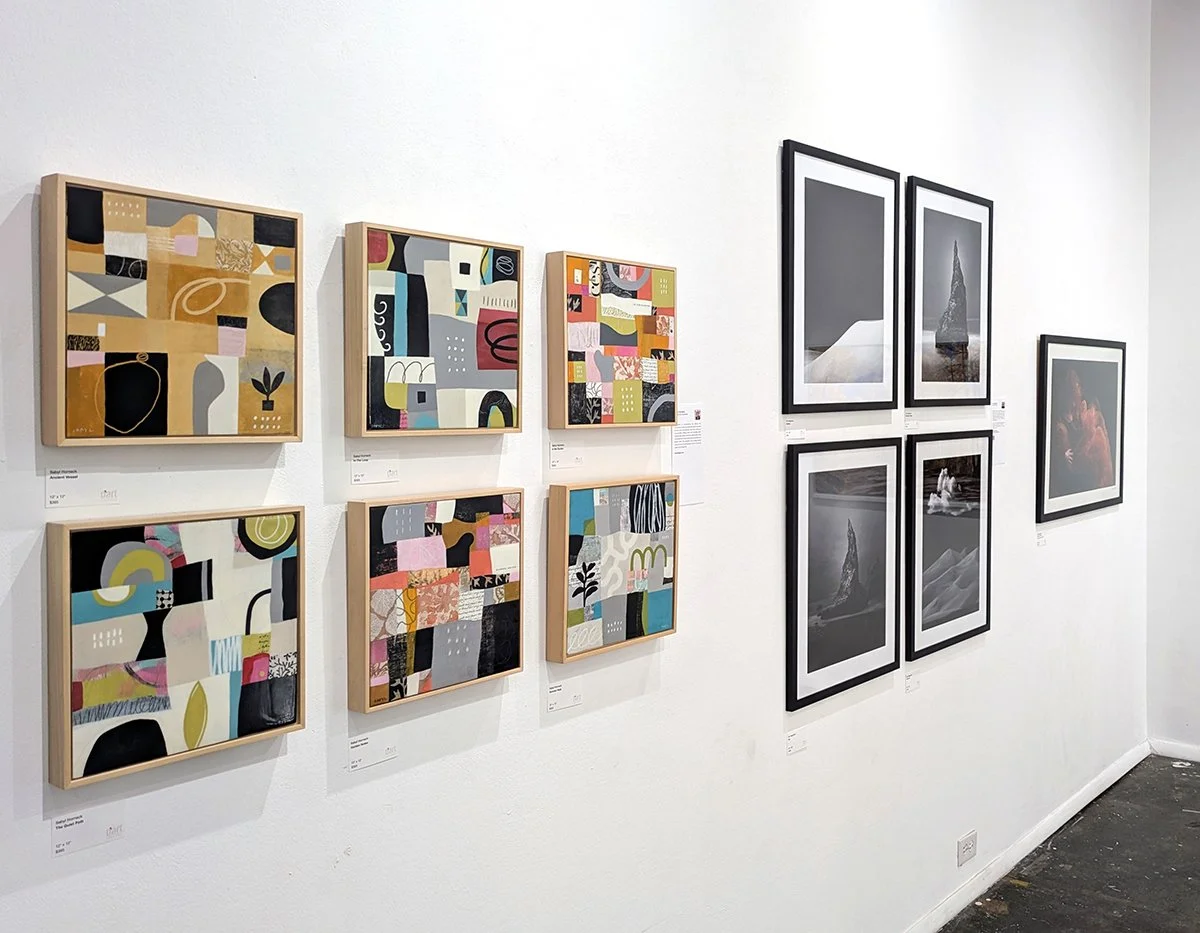Between Here and There
Between Here and There: An Exhibition by D’art Gallery Satellite Members
D'art Gallery
900 Santa Fe Drive, Denver, CO, 80204
November 6–30, 2025
Admission: free
Review by Maggie Sava
On the opening day of D’art Gallery’s satellite member exhibition, Between Here and There, the afternoon sunlight streamed through the large windows into the gallery space, creating an especially welcoming atmosphere. The light itself seemed to be participating in the show, casting playful shadows of D’art’s vinyl sign onto the floor as if inviting you to enjoy the display.
An installation view of the exhibition Between Here and There at D’art Gallery, including the cast shadow of the gallery name. Image by Maggie Sava.
Featuring the work of 20 artists from across the country, Between Here and There has the hefty task to not only bring the audience in, but to keep them engaged while guiding them through the diverse work of each artist. Member shows can risk a lack of cohesion compared to those curated around specific themes or queries. The D’art team avoids this risk and skillfully navigates the broad scope of aesthetics presented by their members through their thoughtful hanging of the show, and by delivering immediate thematic clues to viewers.
An installation view of Between Here and There at D’art Gallery. Image by Maggie Sava.
Upon entering the 360 Gallery, I was met with the title card of the exhibition, which highlights a sculptural stoneware piece by Katelyn Odenheimer, two encaustic works by Rozanne Kobey, and a photograph by Scott Weingarten. These three artists shown side-by-side provide instructive categorical buckets for this show: engagement with nature, abstract works, and figurative representations of the human form.
Katelyn Odenheimer, Biophilia, stoneware and big leaf maple, 27 x 7 x 5 inches. Image by Maggie Sava.
Biophilia is Odenheimer’s only piece in the show, and it is a strong visual draw to start the exhibition. The cylindrical base splits at both ends, and the rough, unfurling top edges paired with the textured, variable surface quality resemble a tree trunk. Placed in a perfectly sized niche within the trunk is the form of a heart, which is integrated into the rest of the form through the shared material, color, and its attached arteries. This piece, which pairs the delicate details and vulnerability of the exposed heart with the solidity of its stoneware material, is Odenheimer’s cathartic means of exploring her complex relationship with anxiety and mental health through her peace-bringing connection to nature. [1]
Sam Elkind, Light in Santa Elena Canyon, 2025, 1/10, archival inkjet print, protected by UV-resistant laminate, 22 x 17 inches. Image by Maggie Sava.
As I embarked on my loop around the display walls of the gallery, I was met with Sam Elkind’s reconstructed landscape photographs. Each image shows pictures reconfigured into atypical shapes, or as Elkind calls them, “novel visual objects,” which challenge the standard rectangles we are used to seeing. In Light in Santa Elena Canyon, 2025, 1/10, Elkind captures the view between two canyon walls, which breaks apart into stepped fragments of the stream that seems to have originally cut through the photographed scene. [2]
Clockwise from top left: Sam Elkind, Encino, New Mexico, 2025, 1/10, archival inkjet print, protected by UV-resistant laminate, 22 x 17 inches. Sam Elkind, Over San Antonio Mountain, 2025, 1/10, archival inkjet print, protected by UV-resistant laminate, 17 x 22 inches. Sam Elkind, Light in Santa Elena Canyon, 2025, 1/10, archival inkjet print, protected by UV-resistant laminate, 22 x 17 inches. Sam Elkind, Play of Light - Jemez Mountains, 2025, 1/10, archival inkjet print, protected by UV-resistant laminate, 17 x 22 inches. Image by Maggie Sava.
The non-traditional structures of Elkind’s prints open a visual path in ways beyond just compositional considerations. Through digital, post-production interventions, Elkind transforms his photos through “apparent folds in the illusory space,” in order to foreground the photograph as object, not pure representation. [3] He asks the viewer to interrogate not only what they see in the natural landscape, but how they are actually seeing it, especially when it is through the mediation of a lens.
Pam Rogers, Smoke Drift, plant and soil pigments, carbon, graphite, copper, and ink, 20 x 16 inches. Image by Maggie Sava.
Pam Rogers uses direct material incorporation in her works on paper to experiment with human influence in the natural world and its various representations, which she achieves by creating pigments out of place-specific plant and soil samples. In Smoke Drift, Rogers shows the micro-environment of a tree branch. However, what might have been an otherwise quaint, symbiotic scene, looks distressed.
A nest in the upper right does not have any birds in it, just unrecognizable gray shapes. In the middle section of the lower half of the image, a winged insect looks like it is drowning in a smothering gray mist, which covers and smudges other parts of the branch. There are a few leaves and flowers, but most of the smaller twigs are bare and sharp. Here, Rogers offers a different angle on our connection with the natural world: instead of reflecting on the calming effect of nature as I did when looking at Odenheimer’s work, I felt the warning call to pay closer attention to ecological harm on all scales.
Top to bottom, left to right: Catherine Brown, Field of Poppies, acrylic on wood panel, 12 x 12 inches. Catherine Brown, Above the Fruited Plain, acrylic on wood panel, 18 x 18 inches. Catherine Brown, Shaken, Not Stirred, acrylic and chalk on canvas, 24 x 24 inches. Catherine Brown, The Sisters at The Art Gallery, acrylic on wood panel, 12 x 12 inches. Catherine Brown, Lazy Q Ranch, acrylic on wood panel, 18 x 18 inches. Image by Maggie Sava.
While many of the artists overlap in their different depictions of nature, a large portion of the works in this show move away from pictorial representation and into abstraction. Catherine Brown’s canvases bridge this broader aesthetic transition in the show, with three being landscape paintings and two others that are expressionist and geometric in nature.
Catherine Brown, Shaken, Not Stirred, acrylic and chalk on canvas, 24 x 24 inches. Image by Maggie Sava.
Shaken, Not Stirred, for example, is made up of shards of colors and forms, which are dissected with a snaking black line. While resembling the painterly style of her other works, it does not show a specific scene, instead focusing on movement, rhythm, and the relationship between the peach, teal, gray, and yellowish-orange colors throughout the painting.
Clockwise from top left: Rozanne Kobey, Quite Decay, encaustic and monotype with yasutomo paper on wood, 12 x 12 inches. Rozanne Kobey, Gilded Echoes, encaustic and monotype with yasutomo paper on wood, 12 x 12 inches. Rozanne Kobey, Ice Forest, encaustic and monotype with yasutomo paper on wood, 12 x 12 inches. Rozanne Kobey, Botanical Veil, encaustic and monotype with yasutomo paper on wood, 12 x 12 inches. Image by Maggie Sava.
Rozanne Kobey, Botanical Veil, encaustic and monotype with yasutomo paper on wood, 12 x 12 inches. Image by Maggie Sava.
Rozanne Kobey’s multimedia pieces also share a relationship with nature, resembling geological, sedimentary samples, while being distinctly abstract. As the name implies, the branching, vein-like lines of Botanical Veil look like organic material, and the dimensionality Kobey creates through the encaustic process gives it a greater sense of substance in the space. These qualities make it seem like this could be part of a living organism, just as her other works look like they could have been carved right out of natural stone, yet they do not depict a specific object. Instead, Kobey uses evocative shapes, lines, colors, and surface qualities to suggest the texture of nature.
Left to right: Donna Fleetwood, She KNOWS…, mixed media on panel, 20 x 20 inches. Donna Fleetwood, Party, mixed media on panel, 16 x 16 inches. Donna Fleetwood, Go West, mixed media on panel, 20 x 20 inches. Donna Fleetwood, Blue Hat, mixed media on panel, 14 x 14 inches. Image by Maggie Sava.
Donna Fleetwood, Blue Hat, mixed media on panel, 14 x 14 inches. Image by Maggie Sava.
As implied at the start of Between Here and There, a third throughline for the exhibiting artists is figurative art centered on the human form. This is primarily shown through portraits, like in Donna Fleetwood’s series of panels featuring different female subjects, most of whom don hats or other vaguely-western wear.
SA Bennett, Singing Guitar, 36 x 48 inches. Image by Maggie Sava.
SA Bennett’s Singing Guitar is also a portrait, this time of a man playing a guitar with a slide on the frets. The artist achieves a great deal of bright expressivity in the work through the color palette, with the vibrant yellow background, the figure’s bold red shirt, the sharp blue of the guitar, and the warm brown tones of the man’s skin, all existing in a joyful harmony. Bennett paints not only a moment in time, but a sense of atmosphere and energy, drawing the viewer into the large emotional landscape of the canvas.
Carol Bivins, American Soil, acrylic, paper and oil on canvas, 52 x 52 inches. Image by Maggie Sava.
While these three main categories are a helpful descriptive skeleton for the show, two works in particular stand apart due to their prominent political themes. Carol Bivins’s American Soil is a visual focal point in Between Here and There for several reasons: it is hung near the front door, making it one of the first canvases you see when you come in; its large scale and bright color scheme make it striking against the gallery walls; and a giant bullseye takes up nearly half of the visual plane. As you get closer, more and more details emerge, like the silhouettes of human forms used at gun ranges for target practice, and the flower at the bottom left that has petals made up of hands holding guns.
A detail of Carol Bivins, American Soil, acrylic, paper and oil on canvas, 52 x 52 inches. Image by Maggie Sava.
As Bivins asserts, American Soil is digging at “where we are as a society, what our culture stands for, and what the future may become.” [4] It could take a long time to decode the different layers and possible messages of this work, including the inclusion of fingerprints in the top left and a marijuana leaf in the top right, but the strongest, clearest critique is of gun culture in America. The painting makes itself a visual target, while pointing weapons right back out at the viewer.
Marc Chicoine, Children’s Crusade - A piece about U.S. accountability, oil on canvas, 36 x 24 inches. Image by Maggie Sava.
Marc Chicoine’s Children’s Crusade - A piece about U.S. accountability, which sits next to American Soil, also draws the eye in with its prominent red background and colorful, Chagall-esque, folky forms floating in an unknown, indeterminate space. The painting offers visual clues as to the message of the work: the central figure is dressed in a pseudo-Uncle Sam, military-like getup, riding what looks to be a mechanized horse; a ghost emerges in the smoke of his cigarette, portending death; and the flag the rider waves bares monetary symbols.
The name of this painting only makes the criticism of the American military-industrial complex more evident. The title “Children’s Crusade” likely refers to an incident in 1212 in which an army of young Europeans attempted (but failed) to claim Jerusalem as part of the larger campaigns of the crusades. [5] This historical context makes it clear that this piece is not just taking a broad stance against America’s approach to war, but is specifically addressing the violence and humanitarian crisis occurring in Gaza, which has in large part been funded by American dollars and weapons given to Israel. [6] An Instagram post by Chicoine confirms this critique, as it offers an alternative subtitle for the painting: Children's Crusade (Enablers of Gaza). [7]
Jon Kitner, Kendrick Lake Ice, 24 x 24 inches Image by Maggie Sava.
An installation view of Between Here and There at D’art Gallery. Image by Maggie Sava.
Between Here and There is a fitting description for D’art’s latest show—between the twenty exhibiting artists, you can take quite the aesthetic and narrative journey. While there might not be a concise thematic or visual thread in the show, it does not feel crowded. The artworks are not competing for attention; instead, you are encouraged to take your time wandering the space, pausing at each distinct stage to take in the individual works and the unexpected, yet serendipitous ways they speak to one another across land, subject matter, and aesthetics. Perhaps you’ll find other threads connecting each artist, creating new conversations with each gallery visit.
Maggie Sava (she/her) is an art historian and writer based in Denver. She holds a BA in art history and English, creative writing from the University of Denver and an MA in contemporary art theory from Goldsmiths, University of London.
[1] Katelyn Odenheimer, artist’s statement, Between Here and There, D’art Gallery, Denver, Colorado.
[2] Sam Elkind, artist’s statement, Between Here and There, D’art Gallery, Denver, Colorado.
[3] Ibid.
[4] Carol Bivins, artist’s statement, Between Here and There, D’art Gallery, Denver, Colorado.
[5] Gary Dickson, “Children’s Crusade,” Britannica, accessed November 9, 2025, https://www.britannica.com/event/Childrens-Crusade.
[6] William D. Hartung “U.S. Military Aid and Arms Transfers to Israel, October 2023 – September 2025,” The Watson School of International and Public Affairs, October 7, 2025, https://costsofwar.watson.brown.edu/paper/AidToIsrael.
[7] Marc Chicoine (@marcchicoine), “Children's Crusade (Enablers of Gaza). Oil on Canvas.,” Instagram, August 26, 2025, https://www.instagram.com/p/DN1vPEu0slg/?utm_source=ig_web_copy_link&igsh=MzRlODBiNWFlZA==.



